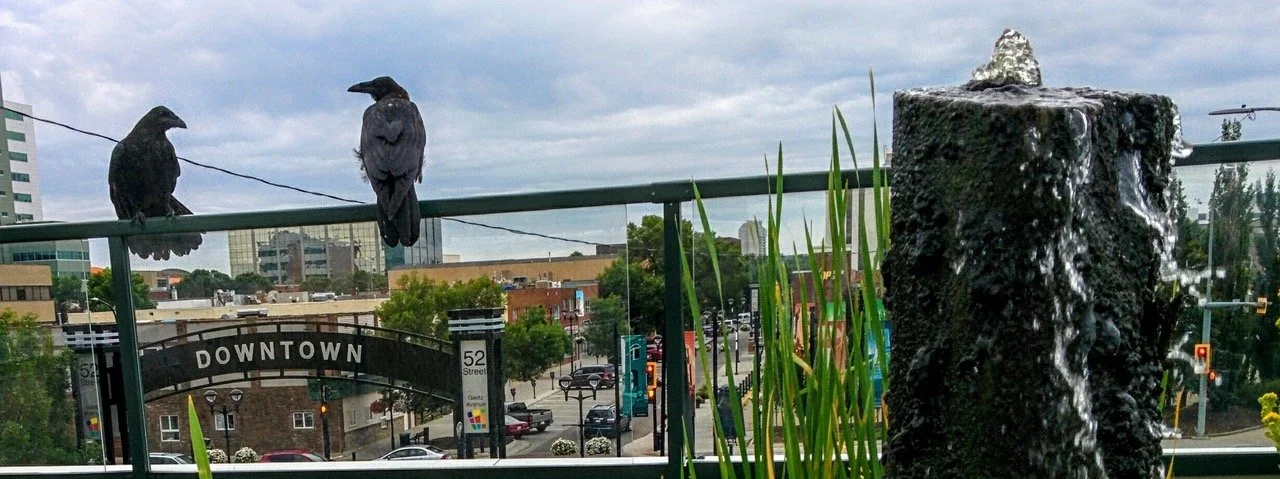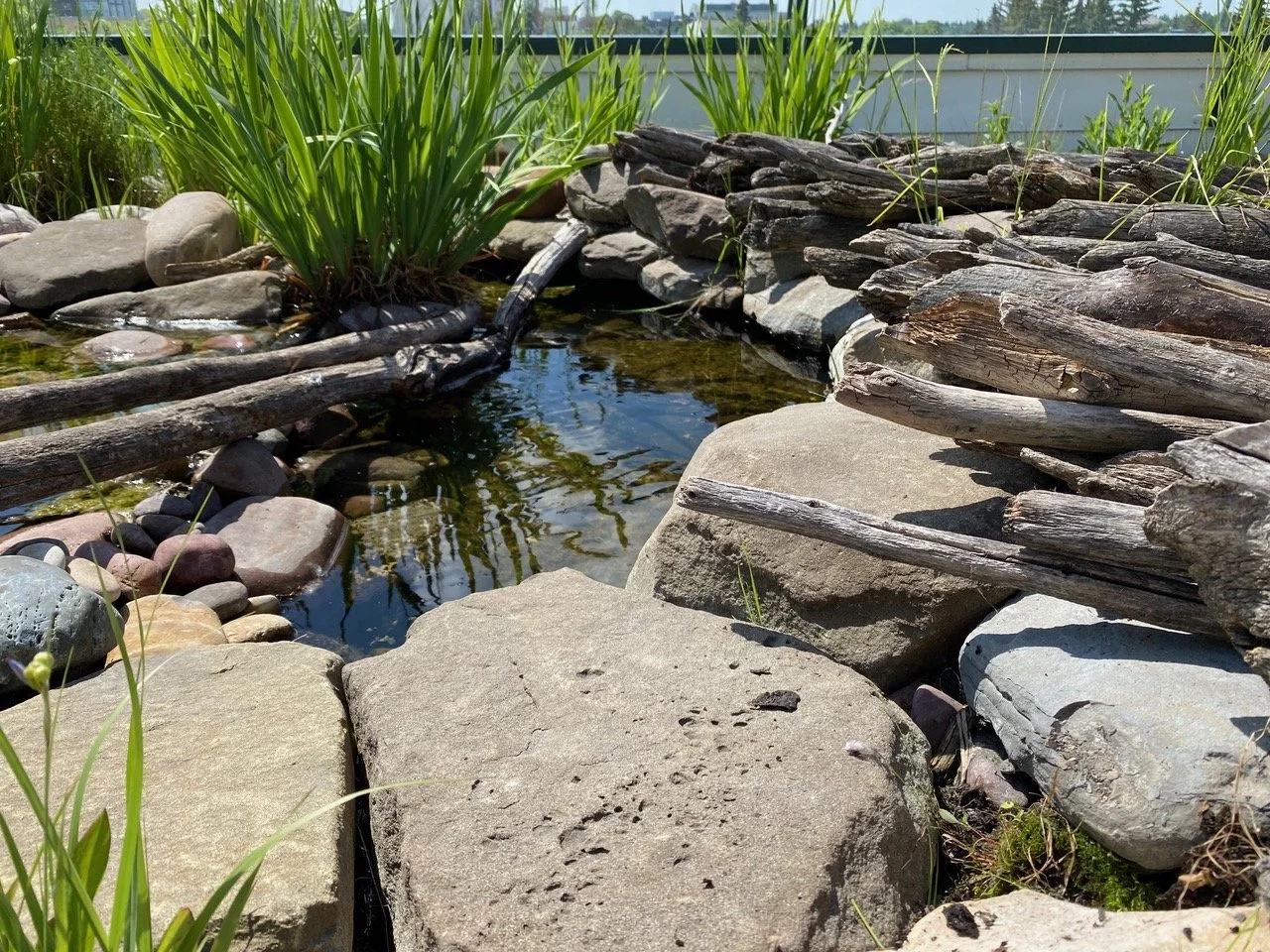A River Runs Through It: The Value of Water on Biodiverse Green Roofs
Advertisement
Local ravens have adopted the flowing stream as a welcome component of their urban ecosystem. Photo: Cynthia Pohl
Frog song, winnowing snipe, and a myriad of bird songs fill the night air. This is the sound of life. The beavers have overwintered well and the creek is high. Every evening, mud and sticks are added to the dam, slowing the flow of water as it moves across the land. Water: the precious resource that we all need.
The creek is arterial to me, just as it is to the abundance of other life forms that call it home. So, when asked to design a biodiverse green roof for Berry Architecture and Associates, I knew there would be water in the design because the presence of water draws in life.
The goal of the project was to model the green roof after the ecoregion in which it is located, in this case the Aspen Parkland. We wanted to bring back the birds, bees, and other insects that once called the footprint of this office building home. To do this we needed to recreate a diverse and rich Aspen Parkland habitat.
Wood lilies, Lilium philadelphicum, snags, and a butterfly hibernaculum situated within the east meadow. Photo: Cynthia Pohl
The green roof is a build-in-place, extensive system with an undulating substrate depth of 20-30cm. Shooting star, Old Man’s Whiskers, Buffalo Bean, and Blue-Eyed Grass are some of the indigenous plants that we selected to build the diverse palette of flowers and vegetation that have transformed the lifeless roof top into a thriving ecosystem. All plants were carefully selected to provide food and/or shelter for pollinators, other insects and birds. Plant characteristics such as bloom time and type, rooting habit, and nitrogen fixing ability were other factors that influenced the plant selection.
Habitat structures also played an important role in the design; a butterfly hibernaculum, boulders, and stone piles, were carefully selected and installed to provide nesting and perching structures for wildlife as well as organic matter for decomposers such as lichens, mosses, bryophytes and fungi. To encourage life on all levels we chose to cover the substrate with shredded pine mulch. Prior to laying the mulch down we broadcast a very small amount of organically rich soil to ‘seed’ the substrate with microbial life. The mulch created a moist environment within the substrate making it a favorable environment for the growth of microbes, as well as providing an immediate source of carbon to feed on. It worked! Within the first year we were already seeing eyelash fungi, and from that year on we continued to see the fruiting bodies of mycelium.
Of all the habitat features, however, the one that draws the most attention from the building’s staff, visitors, birds and insects is the flowing stream. Water catches light, reflecting it back to us, as if beckoning us to take a moment to reflect upon ourselves. It calls to us with its soothing sounds, and it speaks to our core from a deep place of ancestral memory.
Advertisement
The stream runs the full length of the south side of the green roof and is a favourite spot for both people and wildlife. Photo: Cynthia Pohl
The eight metre long stream runs the full length of the south side of the roof top and is the first element to greet visitors when they open the door onto the roof. It is bright, alive, reflecting sunlight, flowing, splashing, gurgling. On one end are three thin, tall jack pine snags perfect for small, perching songbirds. There are also numerous horizontal snags that cross the stream at irregular intervals. These vertical and horizontal snags are used throughout the day by a variety of birds, as though each species has booked their allotted time slot for perching, drinking, and bathing.
The upper basin of the water feature overlooking Red Deer’s downtown core. Photo: Cynthia Pohl
The stream is crystal clear, not due to any high-tech filtration system, but simply as a result of natural processes. A 2900 GPH pump moves water from the lower basin to the upper basin where it flows through a set of three new Shou Sugi Ban treated cedar timbers. Water then flows downstream to the lower basin, where a semicircle of beaver chewed branches frame the water. Small stones line the streambed and create an abundance of surface area for the colonization of beneficial bacteria. These bacteria thrive by consuming decomposing organic material and excess nitrogen that can come along with decomposition. Cattails with their dramatic, stiff, wide, green leaves reaching up and out of the water, are also doing their job to help to filter pollutants and excess nutrients. These cattail stands create protected areas within the stream that support snails and provide perching points for dragonflies.
As our summers get hotter and drier, the presence of water for wildlife within our urban centres becomes more and more important. The presence of water, especially flowing water, as a component of biodiverse green roofs greatly enhances the space’s ability to support life. A water feature does require attention and maintenance but if the design is well thought out the amount of extra maintenance is minimal. One of the initial factors that must be taken into consideration when planning a green roof water feature, is the weight of the materials, including the water. This statistic may dictate whether or not it is even possible to include a water feature or where the feature can be situated.
Advertisement
Edged with stone and wood that has been chewed by beavers, the lower basin of the water feature is a 2400mmx2400mmx150mm reservoir constructed of treated lumber and lined with EPDM rubber liner. Photo: Cynthia Pohl
Maintenance of a living waterway on a rooftop can be broken into three periods: spring, summer, and fall maintenance. In locations where the temperature drops below freezing the pump needs to be pulled from the system and stored indoors and the line from the upper basin to the lower basin blown out. Once temperatures rise above freezing in the spring, the pump will need to be reinstalled and this consists of simply placing it back into the lower basin. Good design can make this a simple task. Ensuring easy access to the edge of the lower pond during the design phase is essential. We were fortunate to have a power outlet close to the lower basin, as well as patio blocks on pedestals enabling us to hide a permanent power cord right up to the edge of the water feature. This made the removal and installation of the pump a very quick procedure. Evaporation, especially during the peak of summer, requires the system to be regularly topped up with water. In our design, it was decided that the staff take turns visiting the roof top early each morning to do the ‘top up’, a task which gives them a few moments to connect to nature. The river water feature uses recirculating potable water, after initial efforts to use collected rainwater did not satisfy the filtration requirements imposed by regulatory authorities. Water features can also be set up with automated systems that adjust the water level to a desired range. Finally, if cattails are a component of the pond or stream, they will need to be thinned out every spring or fall, as they grow quickly! If left unattended they can grow to the edges of the feature and act like a wick to the surrounding substrate resulting in water loss within the system.
Where there is water, there is life. Just as beavers and their habits slow the flow of water and allow riparian zones to act like large sponges, increasing species diversity; biodiverse green roofs also slow the flow of water, holding it like a sponge so it can once again become part of the hydrological cycle. Both beaver ponds and biodiverse green roofs can create refugia where a diversity of life can take hold and expand.
Advertisement
Cynthia Pohl is an accredited Green Roof Professional and Journeyman Landscape Gardener. Cynthia is passionate about the preservation and rebuilding of natural systems, her work in the green roof industry has a focus on biodiverse green roofs that return functional and diverse ecosystems to urban centres. She may be reached at: livlands@telus.net









